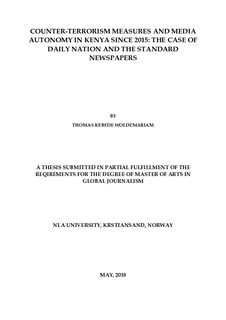| dc.description.abstract | After the US embassy attack in Nairobi in 1998, terrorism has gained a foot in Kenya. According to the reports of international organizations and Kenyan police, AlShabaab claimed responsibility for most of these attacks. Owing to the scholarly posits that, the very purpose of terrorists is not to kill, but to draw attention. The perpetrators exploited the media belligerently questioning the media’s ability to draw a line on passing useful information and glorifying terrorist activities. Like any good government is expected to find solutions to its people’s problems, the Kenyan government came up with new measures when it was faced with one terror attack after another, to tackle a dire issue. This study sets to find out what counter-terrorism measures were set by the Kenyan government and how it affected the functions of media outlets, with a focus on print media, particularly on the case of Daily Nation and The Standard newspapers. To achieve this aim the study applied qualitative research methodology, involving an in-depth interview and quantitative content analysis as techniques of data collection. To select samples, the study mainly adopted the purposive sampling technique. Snowball sampling was also used as an addition. 11 key informants from reporters, editors, and a media expert from Media Council of Kenya and a veteran Journalism professor were interviewed in face-to-face situations. In addition, 52 news articles written by these newspapers between 2015 and 2018 were analyzed. The study based its arguments on media sovereignty theory. The study authoritatively concludes that the counter-terrorism measures built by the government could end up a rat ship. They diminished the freedom of the two newspapers to independently make decisions without fear of possible ramifications. Particularly, individual journalists admitted to coerced self-censorship. Scribes covering terrorism also experienced numerous challenges. The new laws amputate their spirit and broke the boughs in their cradle, leading to the fall of their independence. In sum, the study finds out that, the government turned its guns to the media, with stringent laws and a warning tag to it; ‘anything short of that we will burn you at the stake’. The study suggests workable recommendations aimed at mitigating the effects of allowing counter-terrorism measures to override the autonomy of privately owned media houses including consultations and coordination from both parties. It also, advises the two players to build a rapport with agreements and understanding on how to support each other’s functions and responsibilities for a common good. | nb_NO |
